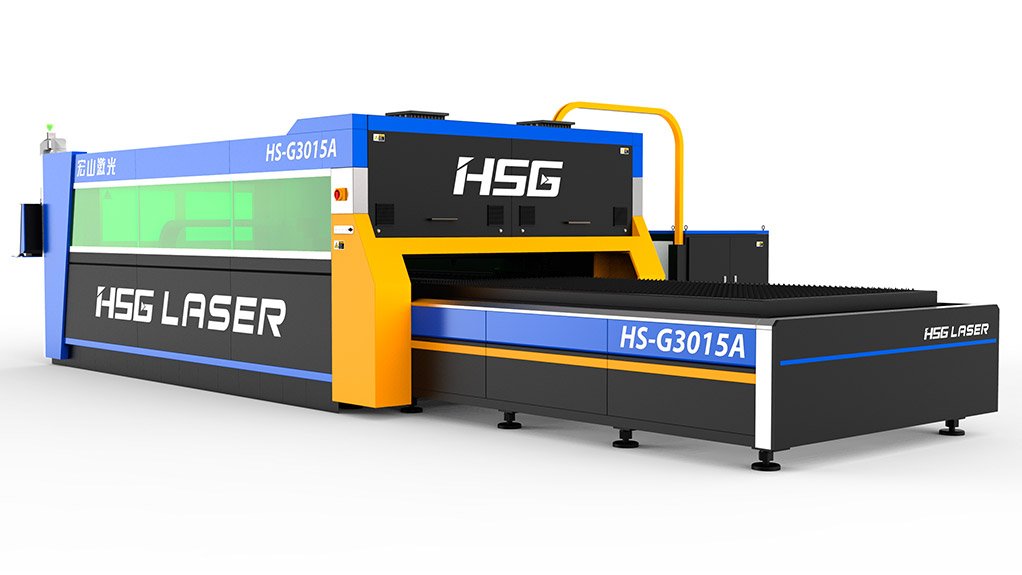To provide end-users with state-of-the-art metal-cutting capabilities, local industrial laser-cutting machine designer, manufacturer, importer and distributor Beyond Laser South Africa (SA) will launch its new flatbed fibre-optic laser-cutting machines, manufactured by China-based laser power processing solutions provider HSG Laser this month.
Thecompany’s aim this year is to increase awareness of the full-protection high-speed capability of the HS-G3015A fibre-optic laser-cutting machine, says Beyond Laser SA MD Mark van der Linde.
This high-speed machine, commonly known as a fibre laser, is specifically designed to cut 0.5 mm to 12 mm carbon steel, 0.5 mm to 10 mm stainless steel, galvanised steel, electrolytic zinc-coated steel sheets, silicon steel, 0.5 mm to 3 mm aluminium, 0.5 mm to 2 mm brass and red copper, as well as other kinds of thin metal sheets.
He points out that the thickness and type of material processing depends on the fibre laser’s power source. Available fibre laser power sources include power sources ranging from 300 W to 3 kW.
The HS-G3015A’s double material loading platforms accelerates the feeding and collecting time of materials, while the full-protection cover reduces laser radiation, Van der Linde says.
Highlighting end-users’ need for cost-effective equipment that includes low maintenance costs, he says the intelligent automatic oil-feeding device of the HS-G3015A extends the life span of the transmitting components, while a high acceleration speed enhances working efficiency.
Electrox Partnership
Beyond Laser SA offers laser-marking specialist Electrox’s entire product range, from the entry-level Raptor – which offers a cost-effective solution for marking metals and plastics – to the Scorpion Rapide, a high-speed machine that allows for complete control of the laser beam parameters to mark a range of different materials, Van der Linde explains.
“Electrox’s product range offers the South African market a marking alternative, with its flexible range of high-quality and competitively priced laser marking and engraving machines,” he says, noting that these solutions have drawn a positive response from the local market.
Beyond Laser SA exhibited Electrox’s Scorpion Rapide laser marker, with the new Electrox Modular Station (EMS) 100 workstation, at the Electra Mining Africa exhibition, in Johannesburg, in September 2014.
The Electrox Scorpion Rapide laser uses the latest fibre-optic technology to provide high-performance laser marking, etching, engraving and pulsed micro-machining on a range of materials, including metals and plastics.
“Advances in fibre-optic technology mean that, in addition to laser marking, the new-generation laser can now be customised to provide customers with access to a variety of industrial applications. Deep engraving, scribing, drilling and trimming are just some of the new applications,” Van der Linde notes. He adds that users also benefit from technology that is durable, permanent and entails a low ownership cost.
Key product features include the lasers’ ability to be integrated in Web-based or a standalone workstation, as well as with available interfaces, including Ethernet cables, USB devices, an RS232 device and digital input/output systems.
Further, the in-built four-axis control unit can be easily integrated into automated production systems or into one of Electrox’s standalone workstations, notes Van der Linde, emphasising that the fibre-optic laser-marking machine is easy to use and requires minimal training for staff, as well as minimal installation and maintenance requirements.
Meanwhile, the new EMS 100 workstation forms part of a wider workstation range. The station features a lift-up door, a laser-safe viewing window and a fume-extraction port, which ensures that the entire marking process is safely conducted, says Van der Linde.
“The workstation technology can be programmed through a computer and is also Windows-compatible, thereby offering enhanced control, flexibility and accuracy.”
Van der Linde notes that this enables a range of different marks to be produced, including barcodes, two-dimensional codes (such as data matrix), as well as data coding and automatic serialisation.
The EMS range also comprises the larger EMS 200 and EMS 300 units for more complex applications, as well as diverse laser-marking options to suit different requirements.
Technological Innovation
Demand is increasing for automated solutions, owing to labour constraints and rising costs. “As with most businesses, we need to deal with increasing labour costs, while financial constraints also result in the demand for more economical and cost-effective innovative equipment,” highlights Van der Linde.
Nevertheless, as a result of the latest technology, which enables ease of operation, new potential can be realised that was not available before, he says,
adding that the company’s small carbon dioxide laser-cutting and engraving machines offer customers an opportunity to start a low-investment small business with profitable returns, owing to the large variety of products that can be manufactured using the machines.
Meanwhile, Beyond Laser SA has included a range of impact-etching machines for tombstone and monument builders, as well as three-dimensional printing equipment for prototyping.
The company continues to expand as a result of innovative and economical technologies, notes Van der Linde, stressing that the company continues to monitor the laser industry to adapt accordingly.
“This is a growing industry, which has not yet reached its full potential in South Africa,” he concludes.
Edited by: Samantha Herbst
Creamer Media Deputy Editor
EMAIL THIS ARTICLE SAVE THIS ARTICLE
To subscribe email subscriptions@creamermedia.co.za or click here
To advertise email advertising@creamermedia.co.za or click here















